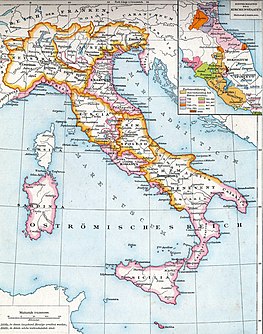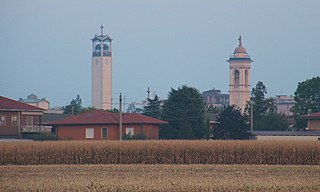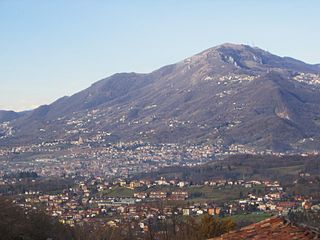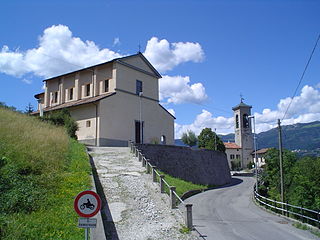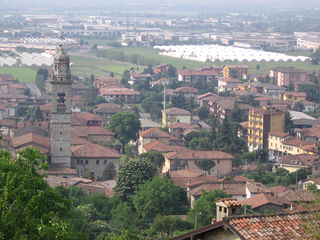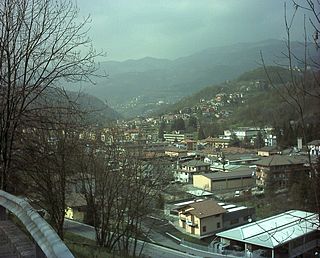| Treviolo | |
|---|---|
| Comune | |
| Comune di Treviolo | |
 Saint George's church | |
| Coordinates: 45°40′22″N9°35′56″E / 45.67278°N 9.59889°E Coordinates: 45°40′22″N9°35′56″E / 45.67278°N 9.59889°E | |
| Country | Italy |
| Region | Lombardy |
| Province | Province of Bergamo (BG) |
| Frazioni | Curnasco, Albegno, Roncola |
| Area | |
| • Total | 8.7 km2 (3.4 sq mi) |
| Elevation | 225 m (738 ft) |
| Population (January 2011) | |
| • Total | 10,363 |
| • Density | 1,200/km2 (3,100/sq mi) |
| Demonym(s) | Treviolesi |
| Time zone | CET (UTC+1) |
| • Summer (DST) | CEST (UTC+2) |
| Postal code | 24048 |
| Dialing code | 035 |
| Website | Official website |
Treviolo (Bergamasque: Treviöl) is a comune (municipality) in the Province of Bergamo in the Italian region of Lombardy, located about 40 kilometres (25 mi) northeast of Milan and about 7 kilometres (4 mi) southwest of Bergamo. As of 1 January 2011, it had a population of 10,363 and an area of 8.7 square kilometres (3.4 sq mi). [1]

The comune is a basic administrative division in Italy, roughly equivalent to a township or municipality.

The Province of Bergamo is a province in the Lombardy region of Italy. It has a population of 1,112,187 (2017), an area of 2,754.91 square kilometers (1,063.68 sq mi), and contains 243 comuni. Its capital is the city of Bergamo.

Italy, officially the Italian Republic, is a country in Southern and Western Europe. Located in the middle of the Mediterranean Sea, Italy shares open land borders with France, Switzerland, Austria, Slovenia and the enclaved microstates San Marino and Vatican City. Italy covers an area of 301,340 km2 (116,350 sq mi) and has a largely temperate seasonal and Mediterranean climate. With around 61 million inhabitants, it is the fourth-most populous EU member state and the most populous country in Southern Europe.
Contents
The municipality of Treviolo contains the frazioni (subdivisions, mainly villages and hamlets) Curnasco, Albegno, and Roncola: Curnasco is the most populated.
"Frazione" is the Italian name given in administrative law to a type of territorial subdivision of a comune; for other administrative divisions, see municipio, circoscrizione, quartiere. It is cognate to the English word fraction, but in practice is roughly equivalent to "parishes" or "wards" in other countries.
Treviolo borders the following municipalities: Bergamo, Bonate Sopra, Bonate Sotto, Curno, Dalmine, Lallio.
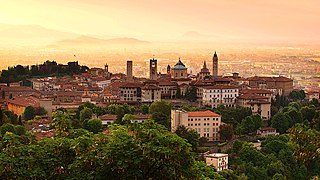
Bergamo is a city in the alpine Lombardy region of northern Italy, approximately 40 km (25 mi) northeast of Milan, and about 30 km (19 mi) from Switzerland, the alpine lakes Como and Iseo and 70 km (43 mi) from Garda and Maggiore. The Bergamo Alps begin immediately north of the city.

Bonate Sopra is a comune (municipality) in the Province of Bergamo in the Italian region Lombardy, located about 40 kilometres (25 mi) northeast of Milan and about 8 kilometres (5 mi) west of Bergamo. As of 31 December 2004, it had a population of 7,042 and an area of 5.9 square kilometres (2.3 sq mi).

Bonate Sotto is a comune (municipality) in the Province of Bergamo in the Italian region of Lombardy, located about 40 kilometres (25 mi) northeast of Milan and about 9 kilometres (6 mi) southwest of Bergamo in the Isola bergamasca.



